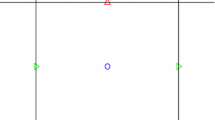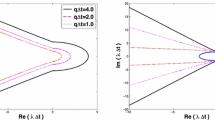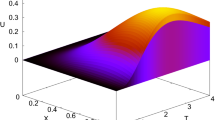Abstract
In the present study, the stability condition for semi-discrete difference schemes of hyperbolic conservation laws obtained from Fourier analysis is simplified. This stability condition can be applied only to linear difference schemes with constant coefficients implemented with periodic boundary treatment. It could often give useful results for other cases, such as schemes with variable coefficients, schemes for nonperiodic problem and nonlinear problem. However, this condition usually leads to a trigonometric inequality, which makes it not convenient to use. For explicit difference schemes on uniform grids, this trigonometric inequality can be converted to polynomial form. Furthermore, if the scheme is a high-order one, the polynomial can be factorized into a simple form. Thus, it is much easier to solve than the inequality obtained directly from Fourier analysis. For compact difference schemes and conservative schemes, similar results are obtained. Some applications of this new stability criterion are shown, including judging the stability of two schemes, proving the upstream central schemes to be stable, constructing a stable upwind dissipation relation preserving (DRP) scheme and constructing an optimized weighted essentially non-oscillatory (WENO) scheme. Since WENO schemes are nonlinear schemes, the stability analysis in the present study is performed on their underlying linear schemes. According to the numerical tests, the underlying linear scheme should be stable, otherwise the corresponding WENO scheme may display instability. These applications demonstrate that this criterion is convenient and efficient for judging the linear stability of semi-discrete difference schemes and constructing stable upwind difference schemes.




Similar content being viewed by others
References
Leveque, R.J.: Numerical Methods for Conservation Laws. Birkhuser, Basel (1990)
Kreiss, H.O., Wu, L.: On the stability definition of difference approximations for the initial boundary value problem. Appl. Numer. Math. 12, 213–227 (1993)
Gustafsson, B., Kreiss, H.O., Sundstrm, A.: Stability theory of difference approximations for mixed initial boundary value problems. II. Math. Comp. 26, 649–686 (1972)
Sengupta, T.K., Ganeriwal, G., De, S.: Analysis of central and upwind compact schemes. J. Comput. Phys. 192(2), 677–694 (2003)
Larsson, J., Gustafsson, B.: Stability criteria for hybrid difference methods. J. Comput. Phys. 227, 2886–2898 (2008)
Ferretti, R.: Convergence of semi-Lagrangian approximations to convex Hamilton-Jacobi equations under (very) large courant numbers. SIAM J. Numer. Anal. 40(6), 2240–2253 (2003)
Qiu, J.M., Shu, C.W.: Convergence of Godunov-type schemes for scalar conservation laws under large time steps. SIAM J. Numer. Anal. 46(5), 2211–2237 (2008)
Jiang, G.S., Shu, C.W.: Efficient implementation of weighted ENO schemes. J. Comput. Phys. 126, 202–228 (1996)
Yamaleev, N.K., Carpenter, M.H.: A systematic methodology for constructing high-order energy stable WENO schemes. J. Comput. Phys. 228(11), 4248–4272 (2009)
Vichnevetsky, R., Bowles, J.B.: Fourier analysis of numerical approximation of hyperbolic equations. SIAM, Philadelphia (1982)
Tam, C.K.W., Webb, J.C.: Dispersion-relation-preserving finite difference schemes for computational acoustics. J. Comput. Phys. 107, 262–281 (1993)
Lin, S.Y., Hu, J.J.: Parameter study of weighted essentially non-oscillatory schemes for computational aeroacoustics. AIAA J. 39, 371–379 (2001)
Lockard, D.P., Brentner, K.S., Atkins, H.L.: High accuracy algorithms for computational aeroacoustics. AIAA J. 33(2), 246–251 (1995)
Andrews, G.E., Askey, R., Roy, R.: Special Functions, 2nd edn. Cambridge Univ. Press, Cambridge (2001)
Lele, S.K.: Compact finite difference schemes with spectral-like resolution. J. Comput. Phys. 103, 16–42 (1992)
Pirozzoli, S.: Conservative hybrid compact-WENO schemes for shock-turbulence interaction. J. Comput. Phys. 178, 81–117 (2001)
Zhuang, M., Chen, R.F.: Applications of high-order optimized upwind schemes for computational aeroacoustics. AIAA J. 40(3), 443–449 (2002)
Liu, X.D., Osher, S., Chan, T.: Weighted essentially non-oscillatory schemes. J. Comput. Phys. 115, 200–212 (1994)
Wang, Z.J., Chen, R.F.: Optimized weighted essentially nonoscillatory schemes for linear waves with discontinuity. J. Comput. Phys. 174, 381–404 (2001)
Martn, M.P., Taylor, E.M., Wu, M., et al.: A bandwidth-optimized WENO scheme for the effective direct numerical simulation of compressible turbulence. J. Comput. Phys. 220, 270–289 (2006)
Stephen, H.F., Arnold, J.I., Lawrence, E.S.: Linear Algebra, 3rd edn. Prentice-Hall, Englewood Cliffs (1997)
Klinger, A.: The vandermonde matrix. Am. Math. Mon. 74(5), 571–574 (1967)
Acknowledgments
This work was supported by the National Science Foundation of China under the Grant number of 11102179 and 91130030. The authors are grateful to the anonymous referees for very fruitful comments.
Author information
Authors and Affiliations
Corresponding author
Appendix
Appendix
1.1 Appendix 1: Proof of Lemma 1
From the expression of \(g_{n}^{l},\) we have
-
(a).
\(g_{n}(p)=g_{-n}(p)\) ;
-
(b).
\(g_{n}^{l}=0\) for \(l>|n|\).
Therefore we need consider only the case \(n\ge 0\). As this is assumed, the expression \(g_{n}(p)=\sum _{l=0}^{L}g_{n}^{l}p^{l} (L\) is an integer larger than \(|n|\)) can be written as \(g_{n}(p)=\sum _{l=0}^{n}g_{n}^{l}p^{l}\).
Mathematical induction will be used to prove it.
-
1.
For \(n=0, g_{0}(p)=g_{0}^{0}p^{0}=1=\cos (0\cdot \kappa )\);
-
2.
For \(n=1, g_{1}(p)=g_{1}^{1}p^{1}+g_{1}^{0}p^{0}=-p+1=\cos (1\cdot \kappa )\);
-
3.
Assume that \(g_{n}(p)=\cos (n\kappa )\) for \(n\le m\) (\(m\ge 1,\ m\in \varvec{N}\)). As for \(n=m+1\),
$$\begin{aligned} g_{m+1}(p)&= \cos [(m+1)\kappa ]=2\cos (\kappa ) \cos (m\kappa )-\cos [(m-1)\kappa ]\\&= 2(-p+1)g_{m}(p)-g_{m-1}(p). \end{aligned}$$That’s
$$\begin{aligned} \sum _{l=0}^{m+1}g_{m+1}^{l}p^{l}=2(-p+1) \sum _{l=0}^{m}g_{m}^{l}p^{l}-\sum _{l=0}^{m-1}g_{m-1}^{l}p^{l}, \end{aligned}$$and this formula is the one which should be proved.
In fact, it is equivalent to that the coefficients of each power of \(p\) in both sides of the equation are equal. Thus, it can be discussed as following:
-
(a).
The coefficients of \(p^{0}\): the equation is \(g_{m+1}^{0}=2g_{m}^{0}-g_{m-1}^{0}\). That is \(1=2\cdot 1-1\), it is true.
-
(b).
The coefficients of \(p^{1}\): the equation is \(g_{m+1}^{1}=2g_{m}^{1}-g_{m-1}^{1}-2g_{m}^{0}\). That is \(-(m+1)^{2}=2m^{2}-(m-1)^{2}-2\cdot 1\), it is also true.
-
(c).
The coefficients of \(p^{l}\), where \(2\le l\le m-1\): the equation is \(g_{m+1}^{l}=2g_{m}^{l}-g_{m-1}^{l}-2g_{m}^{l-1}\).
Furthermore, the formula of \(g_{n}^{l}\) can be written in another form
This form also holds true for \(l=1\), because \(g_{n}^{1}=-n^{2}=n(-2)^{1}\frac{(n+1-1)!}{(n-1)!(2\cdot 1)!}\). So the following equation needs to be proved.
As the factor \((-2)^{l}\frac{(m+l-2)!}{(m-l+1)!(2l)!}\) is extracted, the equation becomes:
After computation, the two sides of the equation are equal to the same value \((m+1)l^{2}+(m+1)(2m-1)l+m(m+1)(m-1)\). Therefore \(g_{m+1}^{l}=2g_{m}^{l}-g_{m-1}^{l}-2g_{m}^{l-1}\) is also true.
-
(d).
The coefficients of \(p^{m}\): the equation is \(g_{m+1}^{m}=2g_{m}^{m}-2g_{m}^{m-1}\). From the expression of \(g_{n}^{l}\), the equation becomes \((m+1)(-2)^{m}=2\cdot (-1)^{m}2^{m-1}-2m(-2)^{m-1}\). Obviously it is true.
-
(e).
The coefficients of \(p^{m+1}\): the equation is \(g_{m+1}^{m+1}=-2g_{m}^{m}\). That’s \((-1)^{m+1}2^{m}=-2\cdot (-1)^{m}2^{m-1}\), which is also true.
Therefore, \(g_{n}(p)=\cos (n\kappa )\) holds for \(n=m+1\). According to the mathematical induction, \(g_{n}(p)=\sum _{l=0}^{n}g_{n}^{l}p^{l}\) is true for all nonnegative integer \(n\). Thus, the proof is completed.
1.2 Appendix 2: Proofs of Lemma 2 and Lemma 3
For brevity, the sums on \(m\),\(n\) in these proofs refer to the sums for \(m=m_{1},\ldots ,m_{2}\) and \(n=n_{1},\ldots ,n_{2}\) respectively, if not specified.
-
the case of explicit difference schemes:
Suppose the scheme is \(q\)-th order accurate. Then the following equations hold:
Note that \(g_{n}^{l}\) is a polynomial of \(n^{2}\) of degree \(l\). It can be written as \(g_{n}^{l}=\sum _{j=0}^{l}c_{l}^{j}(n^{2})^{j}\), where \(c_{l}^{j}\) are the coefficients. Then
From Eq.(6.1), \(\sum _{n}a_{n}(n^{2})^{j}=0\) for \(j=0,1,\ldots ,[q/2]\). Therefore, \(b_{l}=0\) for \(l=0,1,\ldots ,[q/2]\).
-
the case of compact schemes:
According to the proof for explicit difference scheme, the following equations are sufficient condition of the lemma.
By substituing \(\beta _{r}\) with Eq. (2.22), it becomes
For compact scheme (2.19), accuracy of \(q\)-th order requires
Thus, for a positive integer \(p\),
where \(C_{p}^{d}=\frac{p!}{d!(p-d)!}\) is the binomial coefficient. Then
where \(p_{1}=p-1,d_{1}=d-1\). For \(p=2s\), split the summation,
Therefore (6.2) is proved. Then \(b_{l}=0\) for \(l=0,1,\ldots ,[q/2]\).
1.3 Appendix 3: Proof of Lemma 4
Because \(g_{n}^{l}=0\) for \(|l|>|n|\) and \(-n_{1}>n_{2}\ge 0\) ,
Hence, judging the sign of \(a_{n_{1}}\) and \(g_{-n_{1}}^{-n_{1}}\) is on the way. According to the formula of \(g_{n}^{l}, g_{-n_{1}}^{-n_{1}}=(-1)^{-n_{1}}2^{-n_{1}-1}.\) Therefore \(\text{ sgn }\left( g_{-n_{1}}^{-n_{1}}\right) =(-1)^{-n_{1}}\).
As for \(a_{n_{1}}\), it could be obtained by solving Eq. (6.1) with Crammer law [21], that is
where
and \(q+1=n_{2}-n_{1}+1\) is number of the stencil points. According to the formula of Vandermonde determinant [22], \(|A|=\prod _{l=1}^{q}l!>0\).
Akin to the solving procedure of Vandermonde determinant [22],
Then
Therefore \(\text{ sgn }(a_{n_{1}})=\text{ sgn }(|B|)=(-1)^{-n_{1}}=\text{ sgn }\left( g_{-n_{1}}^{-n_{1}}\right) \). As a result, \(b_{-n_{1}}=a_{n_{1}}g_{-n_{1}}^{-n_{1}}>0\). Thus, the proof is completed.
Rights and permissions
About this article
Cite this article
Wu, C., Zhao, N. A Stability Criterion for Semi-Discrete Difference Schemes of Hyperbolic Conservation Laws on Uniform Grids. J Sci Comput 58, 450–471 (2014). https://doi.org/10.1007/s10915-013-9742-8
Received:
Revised:
Accepted:
Published:
Issue Date:
DOI: https://doi.org/10.1007/s10915-013-9742-8




